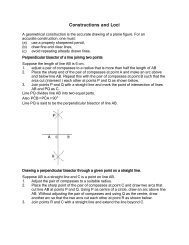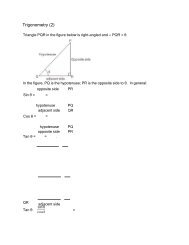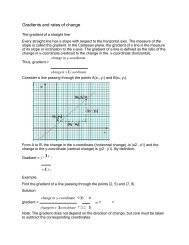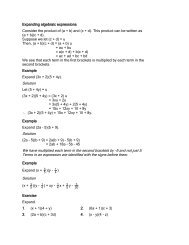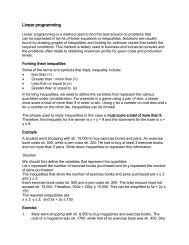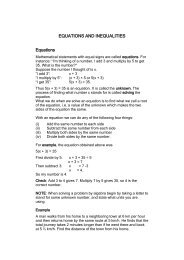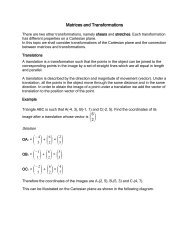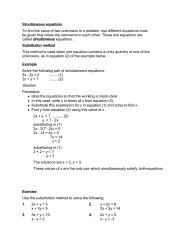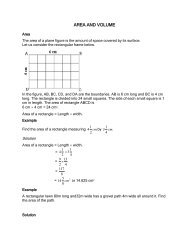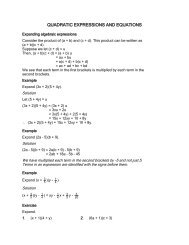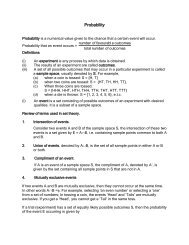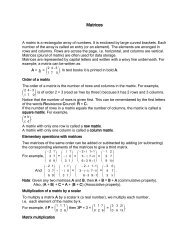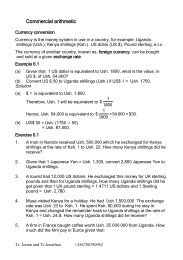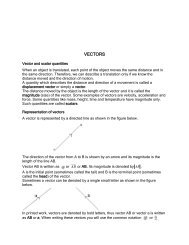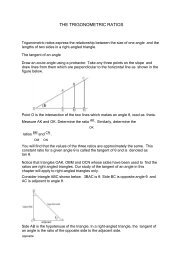ph22
Create successful ePaper yourself
Turn your PDF publications into a flip-book with our unique Google optimized e-Paper software.
www.elearnuganda.net
GASES<br />
• Gases are one of the most pervasive<br />
aspects of our environment on the<br />
Earth. We continually exist with<br />
constant exposure to gases of all<br />
forms.<br />
• The steam formed in the air during a<br />
hot shower is a gas.<br />
• The Helium used to fill a birthday<br />
balloon is a gas.<br />
• The oxygen in the air is an essential<br />
gas for life. www.elearnuganda.net
GASES<br />
A windy day or a still day is a result of the difference in pressure of gases<br />
in two different locations. A fresh breeze on a mountain peak is a study in<br />
basic gas laws.<br />
www.elearnuganda.net
Important Characteristics of Gases<br />
1) Gases are highly compressible<br />
An external force compresses the gas sample and decreases its<br />
volume, removing the external force allows the gas volume to<br />
increase.<br />
2) Gases are thermally expandable<br />
When a gas sample is heated, its volume increases, and when it is<br />
cooled its volume decreases.<br />
3) Gases have high viscosity<br />
Gases flow much easier than liquids or solids.<br />
4) Most Gases have low densities<br />
Gas densities are on the order of grams per liter whereas liquids<br />
and solids are grams per cubic cm, 1000 times greater.<br />
5) Gases are infinitely miscible<br />
Gases mix in any proportion such as in air, a mixture of many gases.<br />
www.elearnuganda.net
Substances That Are Gases under<br />
Normal Conditions<br />
Substance Formula MM(g/mol)<br />
• Helium He 4.0<br />
• Neon Ne 20.2<br />
• Argon Ar 39.9<br />
• Hydrogen H 2 2.0<br />
• Nitrogen N 2 28.0<br />
• Nitrogen Monoxide NO 30.0<br />
• Oxygen O 2 32.0<br />
• Hydrogen Chloride HCl 36.5<br />
• Ozone O 3 48.0<br />
• Ammonia NH 3 17.0<br />
www.elearnuganda.net<br />
• Methane CH 4 16.0
Kinetic Molecular Theory<br />
• To fully understand the world around us<br />
requires that we have a good understanding<br />
of the behavior of gases. The description of<br />
gases and their behavior can be approached<br />
from several perspectives.<br />
• The Gas Laws are a mathematical<br />
interpretation of the behavior of gases.<br />
• However, before understanding the<br />
mathematics of gases, a chemist must have<br />
an understanding of the conceptual<br />
description of gases. That is the purpose of<br />
the Kinetic Molecular Theory.<br />
www.elearnuganda.net
Kinetic Molecular Theory<br />
• The Kinetic Molecular Theory is a single set of<br />
descriptive characteristics of a substance known as<br />
the Ideal Gas.<br />
• All real gases require their own unique sets of<br />
descriptive characteristics. Considering the large<br />
number of known gases in the World, the task of<br />
trying to describe each one of them individually<br />
would be an awesome task.<br />
• In order to simplify this task, the scientific<br />
community has decided to create an imaginary gas<br />
that approximates the behavior of all real gases. In<br />
other words, the Ideal Gas is a substance that does<br />
not exist.<br />
• The Kinetic Molecular Theory describes that gas.<br />
While the use of the Ideal Gas in describing all real<br />
gases means that the descriptions of all real gases<br />
will be wrong, the reality is that the descriptions of<br />
real gases will be close enough to correct that any<br />
errors can be overlooked.<br />
www.elearnuganda.net
The Nature of Gases<br />
Three basic assumptions of the kinetic<br />
theory as it applies to gases:<br />
1. Gas is composed of particles- usually<br />
molecules or atoms<br />
–Small, hard spheres<br />
–Insignificant volume; relatively far<br />
apart from each other<br />
–No attraction or repulsion between<br />
particles<br />
www.elearnuganda.net
The Nature of Gases<br />
2. Particles in a gas move rapidly in<br />
constant random motion<br />
–Move in straight paths, changing<br />
direction only when colliding with one<br />
another or other objects<br />
–Average speed of O 2 in air at 20 o C is<br />
an amazing 1660 km/h!<br />
(1.6km=1mile)<br />
www.elearnuganda.net
The Nature of Gases<br />
3. Collisions are perfectly elasticmeaning<br />
kinetic energy is transferred<br />
without loss from one particle to<br />
another- the total kinetic energy remains<br />
constant<br />
Newtonian Cradle-<br />
Where the collisions between the balls elastic?<br />
Yes, because kinetic energy was transferred<br />
with each collision<br />
www.elearnuganda.net
• Why did the balls eventually stop<br />
swinging? The collisions were not<br />
perfectly elastic, some kinetic energy<br />
was lost as heat during each collision.<br />
• At constant temperatures and low to<br />
moderate pressures, collisions between<br />
gas particles are perfectly elastic<br />
www.elearnuganda.net
THE KINETIC THEORY OF GASES<br />
Remember the assumptions<br />
• Gas consists of large number of particles<br />
(atoms or molecules)<br />
• Particles make elastic collisions with each<br />
other and with walls of container<br />
• There exist no external forces (density<br />
constant)<br />
• Particles, on average, separated by distances<br />
large compared to their diameters<br />
• No forces between particles except when<br />
they collide<br />
www.elearnuganda.net
What happens to a ball when it<br />
drops?<br />
The Which potential is is converted energy into<br />
of to the the potential potential ball energy energy of<br />
in the the ball…………..<br />
…..but in reality the ball<br />
loses height and<br />
eventually stops bouncing<br />
Which Is converted is converted to kinetic to<br />
kinetic energy energy in the ball in the<br />
ball<br />
Why does this<br />
happen?<br />
www.elearnuganda.net
How does the bouncing ball lose<br />
energy?<br />
• Through friction with the air (air<br />
resistance)<br />
• Through sound when it hits the floor<br />
• Through deformation of the ball<br />
• Through heat energy in the bounce<br />
www.elearnuganda.net
www.elearnuganda.net
IDEAL GAS MODEL<br />
• The gas consists of objects with a defined mass<br />
and zero volume.<br />
• The gas particles travel randomly in straight-line<br />
motion where their movement can be described by<br />
the fundamental laws of mechanics.<br />
• All collisions involving gas particles are elastic;<br />
the kinetic energy of the system is conserved even<br />
though the kinetic energy among the particles is<br />
redistributed.<br />
• The gas particles do not interact with each other or<br />
the with the walls of any container.<br />
• The gas phase system will have an average kinetic<br />
energy that is proportional to temperature; the<br />
kinetic energy will be distributed among the<br />
particles according to a Boltzmann type of<br />
distribution.<br />
www.elearnuganda.net
Boltzman Distribution. The behaviour of<br />
the gas molecules under the action of<br />
gravity.<br />
www.elearnuganda.net
Maxwell Distribution. Experiment with<br />
Galton board demonstrates the<br />
statistical sense of Maxwell distribution.<br />
www.elearnuganda.net
Ideal Gas Model<br />
Kinetic Molecular Theory (KMT) for an ideal<br />
gas states that all gas particles:<br />
• are in random, constant, straight-line motion.<br />
• are separated by great distances relative to<br />
their size; the volume of the gas particles is<br />
considered negligible.<br />
• have no attractive forces between them.<br />
• have collisions that may result in the transfer<br />
of energy between gas particles, but the total<br />
energy of the system remains constant.<br />
www.elearnuganda.net
Brownian motion. Chaotic motion of<br />
minute particle suspended in a gas or<br />
liquid<br />
www.elearnuganda.net
This animation illustrates the concept of<br />
free path length of molecules in a gas.<br />
www.elearnuganda.net
Ideal vs. Non-Ideal Gases<br />
x<br />
x<br />
• Kinetic Theory Assumptions<br />
– Point Mass<br />
– No Forces Between Molecules<br />
– Molecules Exert Pressure Via Elastic<br />
Collisions With Walls<br />
www.elearnuganda.net<br />
(courtesy F. Remer)
Ideal vs. Non-Ideal Gases<br />
• Non-Ideal Gas<br />
– Violates Assumptions<br />
• Volume of molecules<br />
• Attractive forces of molecules<br />
www.elearnuganda.net<br />
(courtesy F. Remer)
Deviations from ideal behaviour<br />
• A real gas is most like an ideal gas when the<br />
real gas is at low pressure and high<br />
temperature.<br />
• At high pressures gas particles are close<br />
therefore the volume of the gas particles is<br />
considered.<br />
• At low temperatures gas particles have low<br />
kinetic energy therefore particles have some<br />
attractive force<br />
• Example<br />
• Dry ice, liquid oxygen and nitrogen<br />
www.elearnuganda.net
Ideal Gases<br />
• Behave as described by the ideal gas<br />
equation; no real gas is actually ideal<br />
• Within a few %, ideal gas equation describes<br />
most real gases at room temperature and<br />
pressures of 1 atm or less<br />
• In real gases, particles attract each other<br />
reducing the pressure<br />
• Real gases behave more like ideal gases as<br />
pressure approaches www.elearnuganda.net zero.
Atmospheric Pressure<br />
• Weight of column of air above your head.<br />
• We can measure the density of the<br />
atmosphere by measuring the pressure it<br />
exerts.<br />
www.elearnuganda.net
Effect of Atmospheric Pressure on<br />
Objects at the Earth’s Surface<br />
www.elearnuganda.net
www.elearnuganda.net
Atmospheric Pressure<br />
Pressure = Force per Unit Area<br />
Atmospheric Pressure is the weight of<br />
the column of air above a unit area. For<br />
example, the atmospheric pressure felt<br />
by a man is the weight of the column of<br />
air above his body divided by the area<br />
the air is resting on<br />
P = (Weight of column)/(Area of base)<br />
Standard Atmospheric Pressure:<br />
1 atmosphere (atm)<br />
14.7 lbs/in 2 (psi)<br />
760 Torr (mm Hg)<br />
1013.25 KiloPascals or Millibars (kPa =<br />
N/m 2 )<br />
www.elearnuganda.net
Pressure Measurement<br />
Torricelli's Barometer<br />
• Torricelli determined from this<br />
experiment that the pressure of the<br />
atmosphere is approximately 30<br />
inches or 76 centimeters (one<br />
centimeter of mercury is equal to 13.3<br />
millibars. He also noticed that height<br />
of the mercury varied with changes in<br />
outside weather conditions.<br />
For climatological and meteorological purposes, standard sea-level pressure<br />
is said to be 76.0 cm or 29.92 inches or 1013 millibars<br />
www.elearnuganda.net
The Nature of Gases<br />
Atmospheric pressure results from<br />
the collisions of air molecules with<br />
objects<br />
–Decreases as you climb a mountain<br />
because the air layer thins out as<br />
elevation increases<br />
Barometer is the measuring<br />
instrument for atmospheric<br />
pressure; dependent<br />
www.elearnuganda.netupon<br />
weather
Common Units of Pressure<br />
Unit Atmospheric Pressure Scientific Field<br />
pascal (Pa); 1.01325 x 10 5 Pa SI unit; physics,<br />
kilopascal(kPa) 101.325 kPa chemistry<br />
atmosphere (atm) 1 atm* Chemistry<br />
millimeters of mercury 760 mmHg* Chemistry, medicine,<br />
( mm Hg ) biology<br />
torr 760 torr* Chemistry<br />
pounds per square inch 14.7 lb/in 2 Engineering<br />
( psi or lb/in 2 )<br />
bar 1.01325 bar<br />
www.elearnuganda.net<br />
Meteorology,<br />
chemistry, physics
Converting Units of Pressure<br />
Problem: A chemist collects a sample of carbon dioxide from the<br />
decomposition of limestone (CaCO 3 ) in a closed end manometer, the<br />
height of the mercury is 341.6 mm Hg. Calculate the CO 2 pressure in<br />
torr, atmospheres, and kilopascals.<br />
Plan: The pressure is in mmHg, so we use the conversion factors from<br />
Table 5.2(p.178) to find the pressure in the other units.<br />
Solution:<br />
converting from mmHg to torr:<br />
P CO2 (torr) = 341.6 mm Hg x<br />
1 torr<br />
= 341.6 torr<br />
1 mm Hg<br />
converting from torr to atm:<br />
1 atm<br />
P CO2 ( atm) = 341.6 torr x = 0.4495 atm<br />
760 torr<br />
converting from atm to kPa:<br />
P CO2 (kPa) = 0.4495 atm x<br />
101.325 kPa<br />
1 atm<br />
www.elearnuganda.net<br />
= 45.54 kPa
Change in Pressure<br />
Change in average<br />
atmospheric pressure with<br />
altitude.<br />
www.elearnuganda.net
The Nature of Gases<br />
Gas Pressure – defined as the<br />
force exerted by a gas per unit<br />
surface area of an object<br />
–Due to: a) force of collisions, and b)<br />
number of collisions<br />
–No particles present? Then there<br />
cannot be any collisions, and thus no<br />
pressure – called a vacuum<br />
www.elearnuganda.net
www.elearnuganda.net
Manometers<br />
Manometers measure a pressure difference by balancing the<br />
weight of a fluid column between the two pressures of interest<br />
Rules of thumb:<br />
• When evaluating, start from the known<br />
pressure end and work towards the<br />
unknown end<br />
• At equal elevations, pressure is<br />
constant in the SAME fluid<br />
• When moving down a manometer,<br />
pressure increases<br />
• When moving up a manometer,<br />
pressure decreases<br />
• Only include atmospheric pressure on<br />
open ends<br />
www.elearnuganda.net
www.elearnuganda.net
Manometers<br />
www.elearnuganda.net
Manometers<br />
Example 2<br />
Find the pressure at<br />
point A in this open u-<br />
tube manometer with an<br />
atmospheric pressure P o<br />
P D = γ H2O x h E-D + P o<br />
P c = P D<br />
P B = P C - γ Hg x h C-B<br />
P A = P B<br />
www.elearnuganda.net<br />
P = γ x h + P O
The Gas Laws<br />
• What would Polly<br />
Parcel look like if she<br />
had no gas molecules<br />
inside?<br />
zero molecules = zero pressure inside<br />
zero pressure inside = zero force on the<br />
inside<br />
www.elearnuganda.net
Gas Law Variables<br />
• In order to describe gases, mathematically, it<br />
is essential to be familiar with the variables<br />
that are used. There are four commonly<br />
accepted gas law variables<br />
• Temperature<br />
• Pressure<br />
• Volume<br />
• Moles<br />
www.elearnuganda.net
Temperature<br />
• The temperature variable is always symbolized as T.<br />
• It is critical to remember that all temperature values<br />
used for describing gases must be in terms of<br />
absolute kinetic energy content for the system.<br />
• Consequently, T values must be converted to the<br />
Kelvin Scale. To do so when having temperatures<br />
given in the Celsius Scale remember the conversion<br />
factor<br />
• Kelvin = Celsius + 273<br />
• According to the Kinetic Molecular Theory, every<br />
particle in a gas phase system can have its own<br />
kinetic energy. Therefore, when measuring the<br />
temperature of the system, the average kinetic<br />
energy of all the particles in the system is used.<br />
• The temperature variable is representing the position<br />
of the average kinetic energy as expressed on the<br />
Boltzmann Distribution.<br />
www.elearnuganda.net
Pressure<br />
• The pressure variable is represented by the<br />
symbol P.<br />
• The pressure variable refers to the pressure<br />
that the gas phase system produces on the<br />
walls of the container that it occupies.<br />
• If the gas is not in a container, then the<br />
pressure variable refers to the pressure it<br />
could produce on the walls of a container if it<br />
were in one.<br />
• The phenomenon of pressure is really a force<br />
applied over a surface area. It can best be<br />
expressed by the equation<br />
www.elearnuganda.net
Pressure<br />
• Consider the Pressure equation and the impact of<br />
variables on it.<br />
• The force that is exerted is dependent upon the<br />
kinetic energy of the particles in the system. If the<br />
kinetic energy of the particles increases, for<br />
example, then the force of the collisions with a given<br />
surface area will increase. This would cause the<br />
pressure to increase. Since the kinetic energy of the<br />
particles is increased by raising the temperature,<br />
then an increase in temperature will cause an<br />
increase in pressure.<br />
• If the walls of the container were reduced in total<br />
surface area, there would be a change in the<br />
pressure of the system. By allowing a given quantity<br />
of gas to occupy a container with a smaller surface<br />
area, the pressure of the system would increase.<br />
www.elearnuganda.net
Pressure<br />
• As this container of gas<br />
is heated, the<br />
temperature increases.<br />
As a result, the average<br />
kinetic energy of the<br />
particles in the system<br />
increases.<br />
• With the increase in<br />
kinetic energy, the force<br />
on the available amount<br />
of surface area increases.<br />
As a result, the pressure<br />
of the system increases.<br />
• Eventually,.........................<br />
.Ka-Boom<br />
www.elearnuganda.net
Volume<br />
• The Volume variable is represented by the symbol V.<br />
It seems like this variable should either be very easy<br />
to work with or nonexistent.<br />
• Remember, according to the Kinetic Molecular<br />
Theory, the volume of the gas particles is set at zero.<br />
Therefore, the volume term V seems like it should be<br />
zero.<br />
• In this case, that is not true. The volume being<br />
referred to here is the volume of the container, not<br />
the volume of the gas particles.<br />
• The actual variable used to describe a gas should be<br />
the amount of volume available for the particles to<br />
move around in. In other words<br />
www.elearnuganda.net
Volume<br />
• Since the Kinetic Molecular Theory<br />
states that the volume of the gas<br />
particles is zero, then the equation<br />
simplifies.<br />
• As a result, the amount of available<br />
space for the gas particles to move<br />
around in is approximately equal to the<br />
size of the container.<br />
• Thus, as stated before, the variable V is<br />
the volume of the container.<br />
www.elearnuganda.net
Moles<br />
• The final gas law variable is the quantity of gas. This is always<br />
expressed in terms of moles. The symbol that represents the<br />
moles of gas is n. Notice that, unlike the other variables, it is in<br />
lower case.<br />
• Under most circumstances in chemistry, the quantity of a<br />
substance is usually expressed in grams or some other unit of<br />
mass. The mass units will not work in gas law mathematics.<br />
Experience has shown that the number of objects in a system<br />
is more descriptive than the mass of the objects.<br />
• Since each different gas will have its own unique mass for the<br />
gas particles, this would create major difficulties when working<br />
with gas law mathematics.<br />
• The whole concept of the Ideal Gas says that all gases can be<br />
approximated has being the same. Considering the large<br />
difference in mass of the many different gases available, using<br />
mass as a measurement of quantity would cause major errors<br />
in the Kinetic Molecular Theory.<br />
• Therefore, the mole will standardize the mathematics for all<br />
gases and minimize the chances for errors.<br />
www.elearnuganda.net
Conclusions<br />
There are four variables used mathematically for describing a<br />
gas phase system. While the units used for the variables may<br />
differ from problem to problem, the conceptual aspects of the<br />
variables remain unchanged.<br />
1. T, or Temperature, is a measure of the average kinetic energy of<br />
the particles in the system and MUST be expressed in the<br />
Kelvin Scale.<br />
2. P, or Pressure, is the measure of the amount of force per unit of<br />
surface area. If the gas is not in a container, then P represents<br />
the pressure it could exert if it were in a container.<br />
3. V, or Volume, is a measure of the volume of the container that<br />
the gas could occupy. It represents the amount of space<br />
available for the gas particles to move around in.<br />
4. n, or Moles, is the measure of the quantity of gas. This<br />
expresses the number of objects in the system and does not<br />
directly indicate their masses.<br />
www.elearnuganda.net
Gas Laws<br />
• (1) When temperature is held constant, the density of a<br />
gas is proportional to pressure, and volume is inversely<br />
proportional to pressure. Accordingly, an increase in<br />
pressure will cause an increase in density of the gas and<br />
a decrease in its volume. – Boyles’s Law<br />
• (2) If volume is kept constant, the pressure of a unit<br />
mass of gas is proportional to temperature. If<br />
temperature increase so will pressure, assuming no<br />
change in the volume of the gas.<br />
• (3) Holding pressure constant, causes the temperature of<br />
a gas to be proportional to volume, and inversely<br />
proportional to density. Thus, increasing temperature of<br />
a unit mass of gas causes its volume to expand and its<br />
density to decrease as long as there is no change in<br />
pressure. - Charles’s Law<br />
www.elearnuganda.net
www.elearnuganda.net
Boyle’s Law<br />
• Hyperbolic Relation Between Pressure and<br />
Volume<br />
T 1 T 2 T 3 T 3 >T 2 >T 1<br />
(courtesy F. Remer)<br />
p<br />
isotherms<br />
V<br />
p – V Diagram<br />
www.elearnuganda.net
www.elearnuganda.net
Charles’ Law<br />
• Linear Relation Between Temperature and<br />
Pressure<br />
V 1
Charles’ Law<br />
Real data must be<br />
obtained above<br />
liquefaction<br />
temperature.<br />
Experimental curves for<br />
different gasses,<br />
different masses,<br />
different pressures all<br />
extrapolate to a<br />
common zero.<br />
www.elearnuganda.net
Another version of Charles Law<br />
www.elearnuganda.net
Compression and expansion of<br />
adiabatically isolated gas is accompanied<br />
by its heating and cooling.<br />
www.elearnuganda.net
www.elearnuganda.net
The Gas Laws<br />
• What would Polly<br />
Parcel look like if she<br />
had a temperature of<br />
absolute zero inside?<br />
absolute zero = no molecular motion<br />
no molecular motion = zero force on<br />
the inside<br />
www.elearnuganda.net
Ideal Gas Law<br />
The equality for the four variables involved<br />
in Boyle’s Law, Charles’ Law, Gay-Lussac’s<br />
Law and Avogadro’s law can be written<br />
PV = nRT<br />
R = ideal gas constant<br />
www.elearnuganda.net
PV = nRT<br />
R is known as the universal gas constant<br />
Using STP conditions<br />
P V<br />
R = PV = (1.00 atm)(22.4 L)<br />
nT (1mol) (273K)<br />
n<br />
T<br />
= 0.0821 L-atm<br />
www.elearnuganda.net mol-K
Learning Check<br />
What is the value of R when the STP value<br />
for P is 760 mmHg?<br />
www.elearnuganda.net
Solution<br />
What is the value of R when the STP value<br />
for P is 760 mmHg?<br />
R = PV = (760 mm Hg) (22.4 L)<br />
nT (1mol) (273K)<br />
= 62.4 L-mm Hg<br />
mol-K<br />
www.elearnuganda.net
Learning Check<br />
Dinitrogen monoxide (N 2 O), laughing gas,<br />
is used by dentists as an anesthetic. If 2.86<br />
mol of gas occupies a 20.0 L tank at 23°C,<br />
what is the pressure (mmHg) in the tank in<br />
the dentist office?<br />
www.elearnuganda.net
Solution<br />
Set up data for 3 of the 4 gas variables<br />
Adjust to match the units of R<br />
V = 20.0 L<br />
T = 23°C + 273<br />
n = 2.86 mol<br />
20.0 L<br />
296 K<br />
2.86 mol<br />
P = ? ?<br />
www.elearnuganda.net
Rearrange ideal gas law for unknown P<br />
P = nRT<br />
V<br />
Substitute values of n, R, T and V and<br />
solve for P<br />
P = (2.86 mol)(62.4L-mmHg)(296 K)<br />
(20.0 L) (K-mol)<br />
= 2.64 x 10 3 mm Hg<br />
www.elearnuganda.net
Learning Check<br />
A 5.0 L cylinder contains oxygen gas<br />
at 20.0°C and 735 mm Hg. How many<br />
grams of oxygen are in the cylinder?<br />
www.elearnuganda.net
Solution<br />
Solve ideal gas equation for n (moles)<br />
n = PV<br />
RT<br />
= (735 mmHg)(5.0 L)(mol K)<br />
(62.4 mmHg L)(293 K)<br />
= 0. 20 mol O 2 x 32.0 g O 2 = 6.4 g O 2<br />
www.elearnuganda.net<br />
1 mol O 2
Molar Mass of a gas<br />
What is the molar mass of a gas if 0.250 g of<br />
the gas occupy 215 mL at 0.813 atm and<br />
30.0°C?<br />
n = PV = (0.813 atm) (0.215 L) = 0.00703 mol<br />
RT<br />
(0.0821 L-atm/molK) (303K)<br />
Molar mass = g = 0.250 g = 35.6 g/mol<br />
mol<br />
0.00703 mol<br />
www.elearnuganda.net
Density of a Gas<br />
Calculate the density in g/L of O 2 gas at STP.<br />
From STP, we know the P and T.<br />
P = 1.00 atm<br />
T = 273 K<br />
Rearrange the ideal gas equation for moles/L<br />
PV = nRT PV = nRT P = n<br />
RTV RTV RT V<br />
www.elearnuganda.net
Substitute<br />
(1.00 atm ) mol-K = 0.0446 mol O 2 /L<br />
(0.0821 L-atm) (273 K)<br />
Change moles/L to g/L<br />
0.0446 mol O 2 x 32.0 g O 2 = 1.43 g/L<br />
1 L 1 mol O 2<br />
Therefore the density of O 2 gas at STP is<br />
1.43 grams per liter<br />
www.elearnuganda.net
Formulas of Gases<br />
A gas has a % composition by mass of<br />
85.7% carbon and 14.3% hydrogen. At<br />
STP the density of the gas is 2.50 g/L.<br />
What is the molecular formula of the<br />
gas?<br />
www.elearnuganda.net
Formulas of Gases<br />
Calculate Empirical formula<br />
85.7 g C x 1 mol C = 7.14 mol C/7.14 = 1 C<br />
12.0 g C<br />
14.3 g H x 1 mol H = 14.3 mol H/ 7.14 = 2 H<br />
1.0 g H<br />
Empirical formula = CH 2<br />
EF mass = 12.0 + 2(1.0) = 14.0 g/EF<br />
www.elearnuganda.net
Using STP and density ( 1 L = 2.50 g)<br />
2.50 g x 22.4 L = 56.0 g/mol<br />
1 L 1 mol<br />
n = EF/ mol = 56.0 g/mol = 4<br />
14.0 g/EF<br />
molecular formula<br />
CH 2 x 4 = C 4 H 8<br />
www.elearnuganda.net
Gases in Chemical Equations<br />
On December 1, 1783, Charles used 1.00 x 10 3<br />
lb of iron filings to make the first ascent in a<br />
balloon filled with hydrogen<br />
Fe(s) + H 2 SO 4 (aq) FeSO 4 (aq) + H 2 (g)<br />
At STP, how many liters of hydrogen<br />
gas were generated?<br />
www.elearnuganda.net
Solution<br />
lb Fe g Fe mol Fe mol H 2 L H 2<br />
1.00 x 10 3 lb x 453.6 g x 1 mol Fe x 1 mol H 2<br />
1 lb 55.9 g 1 mol Fe<br />
x 22.4 L H 2 = 1.82 x 10 5 L H 2<br />
1 mol H 2<br />
Charles generated 182,000 L of hydrogen to fill his<br />
air balloon.<br />
www.elearnuganda.net
Learning Check<br />
How many L of O 2 are need to react 28.0 g<br />
NH 3 at 24°C and 0.950 atm?<br />
4 NH 3 (g) + 5 O 2 (g) 4 NO(g) + 6 H 2 O(g)<br />
www.elearnuganda.net
Solution<br />
Find mole of O 2<br />
28.0 g NH 3 x 1 mol NH 3 x 5 mol O 2<br />
17.0 g NH 3 4 mol NH 3<br />
= 2.06 mol O 2<br />
V = nRT = (2.06 mol)(0.0821)(297K) = 52.9 L<br />
P<br />
0.950 atm<br />
www.elearnuganda.net
Mixture of gases<br />
www.elearnuganda.net
Reacting mixture of gases<br />
www.elearnuganda.net
Learning Check<br />
A.If the atmospheric pressure today is 745<br />
mm Hg, what is the partial pressure (mm<br />
Hg) of O 2 in the air?<br />
1) 35.6 2) 156 3) 760<br />
B. At an atmospheric pressure of 714, what is<br />
the partial pressure (mm Hg) N 2 in the air?<br />
1) 557 2) 9.14 3) 0.109<br />
www.elearnuganda.net
Solution<br />
A.If the atmospheric pressure today is 745<br />
mm Hg, what is the partial pressure (mm<br />
Hg) of O 2 in the air?<br />
2) 156<br />
B. At an atmospheric pressure of 714, what is<br />
the partial pressure (mm Hg) N 2 in the air?<br />
1) 557<br />
www.elearnuganda.net
Partial Pressure<br />
Partial Pressure<br />
Pressure each gas in a mixture would exert<br />
if it were the only gas in the container<br />
Dalton's Law of Partial Pressures<br />
The total pressure exerted by a gas mixture<br />
is the sum of the partial pressures of the<br />
gases in that mixture.<br />
P T = P 1 + P 2 + P 3 + .....<br />
www.elearnuganda.net
Partial Pressures<br />
The total pressure of a gas mixture depends<br />
on the total number of gas particles, not on<br />
the types of particles.<br />
STP<br />
P = 1.00 atm<br />
P = 1.00 atm<br />
1.0 mol He<br />
0.50 mol O 2<br />
+ 0.20 mol He<br />
+ 0.30 mol N 2<br />
www.elearnuganda.net
Health Note<br />
When a scuba diver is several hundred feet<br />
under water, the high pressures cause N 2 from<br />
the tank air to dissolve in the blood. If the<br />
diver rises too fast, the dissolved N 2 will form<br />
bubbles in the blood, a dangerous and painful<br />
condition called "the bends". Helium, which is<br />
inert, less dense, and does not dissolve in the<br />
blood, is mixed with O 2 in scuba tanks used for<br />
deep descents. www.elearnuganda.net
Learning Check<br />
A 5.00 L scuba tank contains 1.05 mole of<br />
O 2 and 0.418 mole He at 25°C. What is the<br />
partial pressure of each gas, and what is<br />
the total pressure in the tank?<br />
www.elearnuganda.net
Solution G20<br />
P = nRT P T = P O + P He<br />
V<br />
2<br />
P T = 1.47 mol x 0.0821 L-atm x 298 K<br />
= 7.19 atm<br />
5.00 L (K mol)<br />
www.elearnuganda.net
Micro Effusion<br />
www.elearnuganda.net
Macro Effusion<br />
www.elearnuganda.net
www.elearnuganda.net



